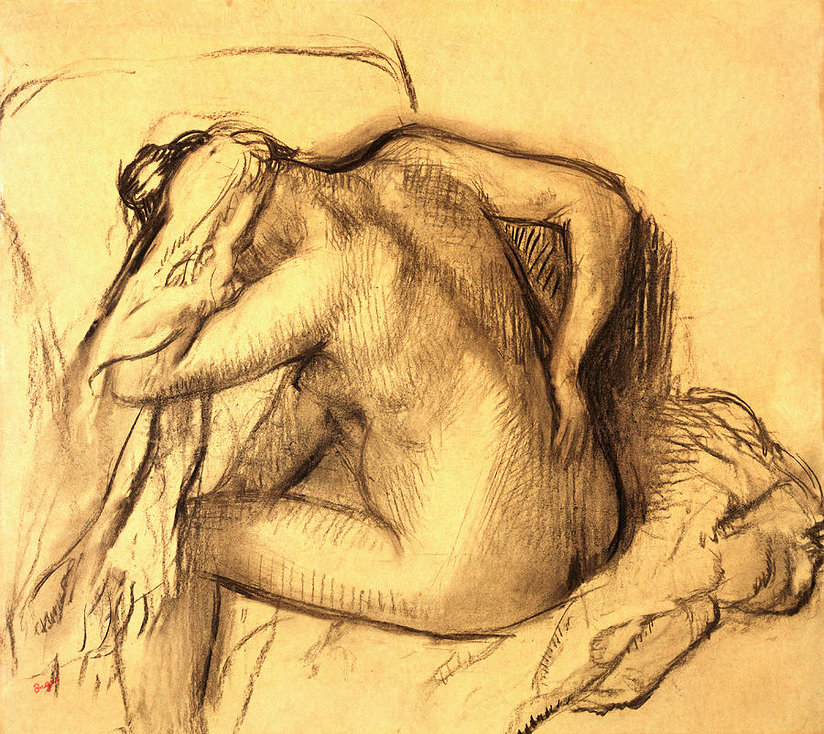Anatomy as a guide to looking
The study of anatomy was for hundreds of years considered as an essential part of a serious artist’s education. In the twentieth century its importance waned. Nowadays, with art school teachers showing less interest in depicting nude models, it has long disappeared from the curriculum of many art schools. However, non-vocational life-drawing classes seem to be as popular as ever.
In my book, I treat anatomy, not as a means of constructing images, but for other purposes: First as a guide for looking, second, as a means of training the memory and, third, as a consequence of the other two, as a method of enhancing the speed, accuracy and expressive potential of information pick-up skills.
Below are three images by Auguste Rodin. Significantly, he was a pupil and lifelong devotee of the influential 19th century teacher Horace Lecoq de Boisbaudran, who developed a rigorous method for training the memory. His aim, like mine, was to help his students to liberate their personal creativity from the straitjacket of slavish copying. He strongly believed in the liberating potential of a deep knowledge of anatomy. He realised that, when you analyse appearances, the more you have an idea, not only of what to look for but also of what your existing knowledge expects to find, the better equipped to discover their uniqueness. It provides us with the opportunity to make same/difference judgments between our expectations and the uniqueness of what we actually find. In other words, it offers a method that enables us both to use our knowledge to go beyond our knowledge into the unknown and, when we arrive, to have a good chance of expanding our awareness fruitfully.
CHAPTER 19 – ANATOMY: A HISTORICAL CONTEXT
Images by two artists with an arguably unsurpassed knowledge of human anatomy
I have chosen these two artists because there is good reason to believe that both benefited from the ideas of Horace Lecoq de Boisbaudran. Rodin was a student of his in the middle of the 19th century and , at the beginning of the 20th century, forcefully acknowledged his own lifelong debt to his teaching. Degas was a great friend of Alphonse Legros, who was known as Lecoq Boisbaudran’s star student and who was well known to be a proselytizer of his ideas. It seems to be no coincidence that the best statement I know of Lecoq Boisbaudran’s philosophy is the following quotation from by Degas:
“It is all very well to copy what you see; it is much better to draw what you only see in memory. There is a transformation during which the imagination works in conjunction with the memory. You only put down what made an impression on you, that is to say the essential. Then your memory and your invention are freed from the dominating influence of nature. That is why pictures made by a man with a trained memory, who knows thoroughly both the masters and his own craft, are almost always remarkable works; for instance Eugène Delacroix.”
The emphasis on the need for a “trained memory” and a thorough knowledge of the artist’s “craft” reflects the core idea that meaningful “freedom of expression” only comes to those who have experienced rigorous methods of finding out what you are looking at, such as those proposed by Horace Lecoq de Boisbaudran. Degas would surely have argued that the expressive freedom shown in the drawings below owed much to the his own and Rodin’s deep and hard won knowledge of human anatomy.
Auguste Rodin



Edgar Degas



Chapters so far published from
Book 1 and Book 2 of “Drawing on Both Sides of the Brain” (Volume 1 of the series of four volumes)
BOOK 1 : “DRAWING WITH FEELING”
Chapters so far loaded:
- Introduction to book 1 of “Drawing with Feeling”
- Chapter 1: Accuracy versus expression
- Chapter 2: Traditional artistic practices
- Chapter 3: Modernist ideas that fed into new teaching methods
- Chapter 4: the sketch and explaining the feel-system
- Chapter 5: Negative spaces
- Chapter 6: Contour drawing
- Chapter 7: Copying Photographs
- Chapter 8: Movement, speed & memory
- Chapter 9: The drawing lesson- preparation
BOOK 2 : “DRAWING WITH KNOWLEDGE”
Chapters so far loaded:
- Chapter 13 : Introduction to “Drawing with Knowledge”
- Chapter 14 : Linear Perspective
- Chapter 15 : Some core ideas
- Chapter 16 : Eye-line problems
- Chapter 17 : Head movement opportunities
- Chapter 18 : Anatomy reviewed
Full list of Posts in all categories
Back to the top of the page
I certainly agree and can personally attest to the truth value regarding rigorous analysis and memory work. Oftentimes when I paint florals, I will first draw the flowers with an aim towards understand, and then when the moment comes to render them in mixed-media, for example, I work from memory, which generates loose, compelling images.
This is an excellent article Francis. My sense is that it is rarely taught in art schools. It offers great inspiration to dedicate time and focus to discover the particularities of what we look at. The gifts of that effort are huge as you illustrate so well. Degas’ quote is wonderful. Thank you for sharing this!